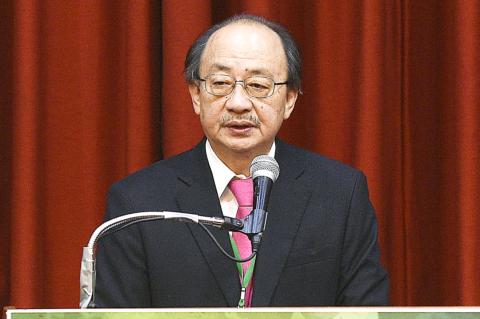The Democratic Progressive Party (DPP) caucus yesterday said it would redraft a proposed bill on monitoring cross-strait agreements in line with the Republic of China (ROC) Constitution, meaning the terms “Taiwan” and “China” would be changed to “Taiwan Area” and “Mainland Area.”
“We will submit an official caucus proposal for a bill to monitor cross-strait negotiations and agreements by the end of the month,” DPP caucus whip Ker Chien-ming (柯建銘) said after a meeting to prepare DPP lawmakers for the legislative session scheduled to begin today. “As for the name of the bill, we will refer to the ROC constitutional framework; we will not use the names we used in the past.”
Ker said that as the new bill is to conform with the ROC constitutional framework, not only would its title be changed, but some of its content would also be adjusted.

Photo: Chen Chih-chu, Taipei Times
The original bill drafted by the DPP in the previous legislature was called “Regulations for Handling Agreements between Taiwan and China,” with a preamble stating that the law was meant to regulate issues concerning the signing of agreements between Taiwan and China.
However, since the caucus has decided to follow the ROC constitutional framework, the terms “Taiwan” and “China” would be changed to “Taiwan Area” and “Mainland Area” in accordance with the Constitution and relevant laws on cross-strait issues.
New Power Party executive chairman Huang Kuo-chang (黃國昌) said Ker’s comments were unclear and that the DPP had an obligation to explain if and why its position had changed.
The “framework of the Constitution of the Republic of China” can be interpreted in different ways, depending on which part of the Constitution is referenced, Huang said.
He said that if the “framework” refers to the sovereignty invested by the Constitution in Taiwanese, it would not necessarily represent a denial of the “two states” dictum (兩國論), which was premised on the legal theory that the nation has already achieved de facto independence as a result of constitutional amendments passed during the democratization process.
Any framework that relegates Taiwan to the status of an “area” of the Republic of China and includes a Chinese “mainland” would be “unacceptable,” he said.
“We have invested a lot of energy into constructing a Taiwanese national consciousness and most Taiwanese have already accepted the fact that China and Taiwan are different countries — do you really want to go back 20 years and say that we are really ‘one country with two areas’?” Huang said.
The “one country with two areas” stance goes against common sense, while the 11th amendment which enshrined it into the Constitution was illegitimate because it had been passed by “lifelong” lawmakers who held their seats from 1949 until 1992, he said.

CROSS-STRAIT COLLABORATION: The new KMT chairwoman expressed interest in meeting the Chinese president from the start, but she’ll have to pay to get in Beijing allegedly agreed to let Chinese Nationalist Party (KMT) Chairwoman Cheng Li-wun (鄭麗文) meet with Chinese President Xi Jinping (習近平) around the Lunar New Year holiday next year on three conditions, including that the KMT block Taiwan’s arms purchases, a source said yesterday. Cheng has expressed interest in meeting Xi since she won the KMT’s chairmanship election in October. A source, speaking on condition of anonymity, said a consensus on a meeting was allegedly reached after two KMT vice chairmen visited China’s Taiwan Affairs Office Director Song Tao (宋濤) in China last month. Beijing allegedly gave the KMT three conditions it had to

STAYING ALERT: China this week deployed its largest maritime show of force to date in the region, prompting concern in Taipei and Tokyo, which Beijing has brushed off Deterring conflict over Taiwan is a priority, the White House said in its National Security Strategy published yesterday, which also called on Japan and South Korea to increase their defense spending to help protect the first island chain. Taiwan is strategically positioned between Northeast and Southeast Asia, and provides direct access to the second island chain, with one-third of global shipping passing through the South China Sea, the report said. Given the implications for the US economy, along with Taiwan’s dominance in semiconductors, “deterring a conflict over Taiwan, ideally by preserving military overmatch, is a priority,” it said. However, the strategy also reiterated

‘BALANCE OF POWER’: Hegseth said that the US did not want to ‘strangle’ China, but to ensure that none of Washington’s allies would be vulnerable to military aggression Washington has no intention of changing the “status quo” in the Taiwan Strait, US Secretary of Defense Pete Hegseth said on Saturday, adding that one of the US military’s main priorities is to deter China “through strength, not through confrontation.” Speaking at the annual Reagan National Defense Forum in Simi Valley, California, Hegseth outlined the US Department of Defense’s priorities under US President Donald Trump. “First, defending the US homeland and our hemisphere. Second, deterring China through strength, not confrontation. Third, increased burden sharing for us, allies and partners. And fourth, supercharging the US defense industrial base,” he said. US-China relations under

The Chien Feng IV (勁蜂, Mighty Hornet) loitering munition is on track to enter flight tests next month in connection with potential adoption by Taiwanese and US armed forces, a government source said yesterday. The kamikaze drone, which boasts a range of 1,000km, debuted at the Taipei Aerospace and Defense Technology Exhibition in September, the official said on condition of anonymity. The Chungshan Institute of Science and Technology and US-based Kratos Defense jointly developed the platform by leveraging the engine and airframe of the latter’s MQM-178 Firejet target drone, they said. The uncrewed aerial vehicle is designed to utilize an artificial intelligence computer